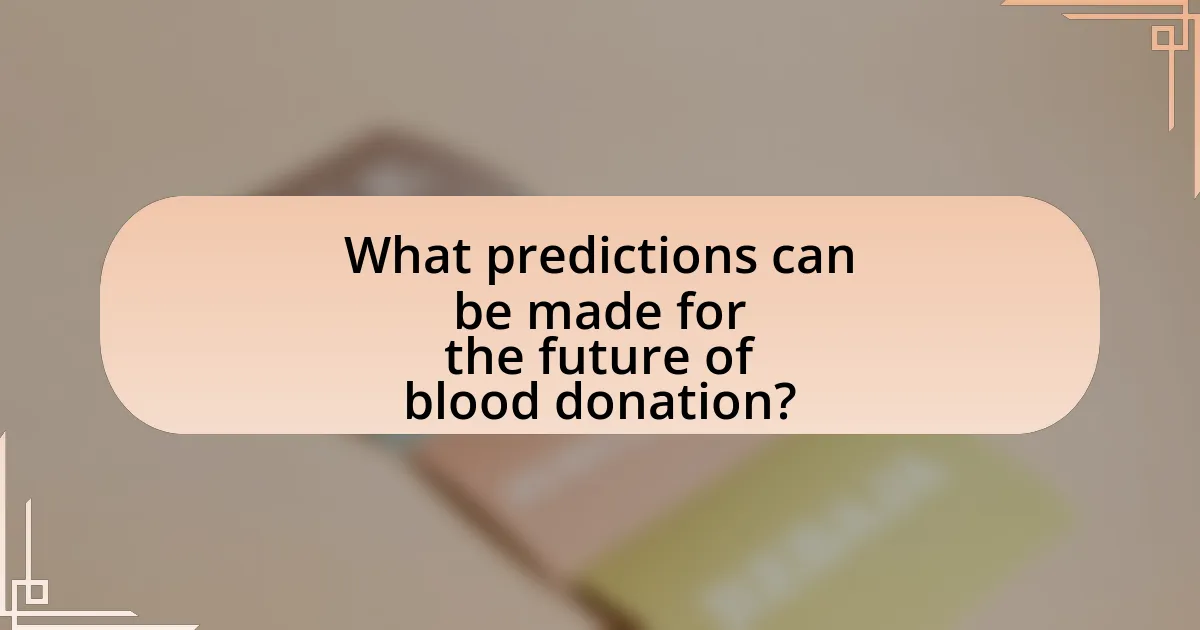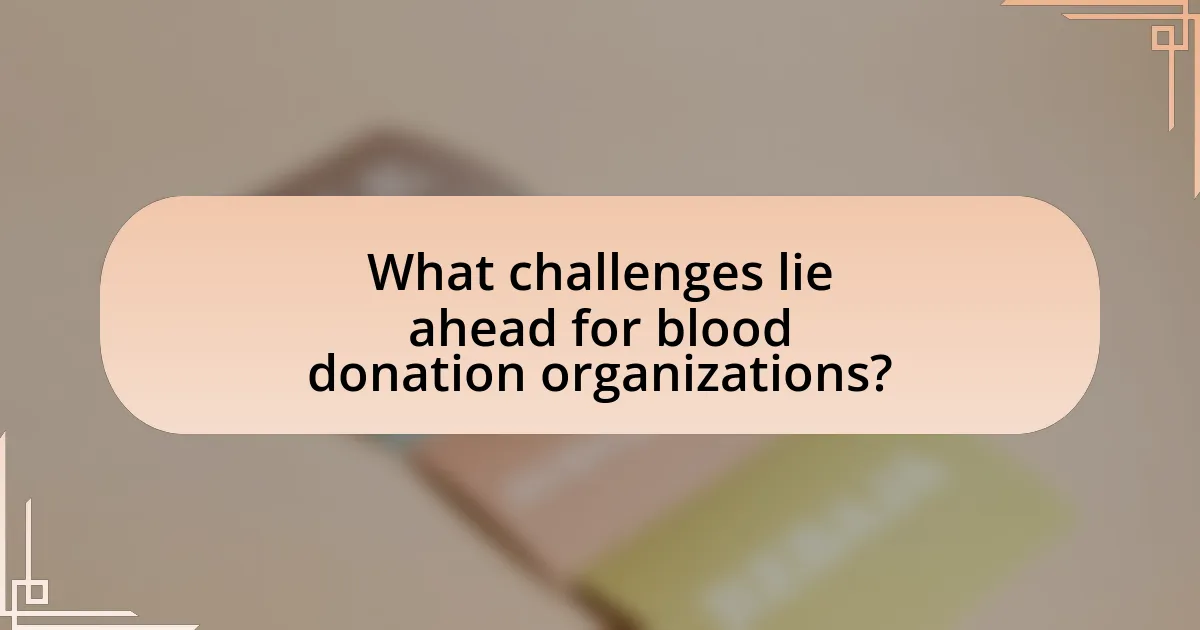The article examines the future of blood donation, highlighting current trends and predictions for the next decade. Key trends include the increased use of technology, such as mobile apps and social media campaigns, to enhance donor engagement and diversify the donor pool. It also addresses demographic shifts affecting donation rates, the impact of cultural factors, and the role of government initiatives in promoting blood donation. Additionally, the article discusses challenges faced by blood donation organizations, ethical considerations, and best practices for improving donor participation and ensuring equitable access to donation opportunities.
What are the current trends in blood donation?

Current trends in blood donation include an increased reliance on technology, a focus on donor diversity, and the promotion of regular donation campaigns. Technology is enhancing the donation process through mobile apps that facilitate scheduling and tracking donations, as well as virtual blood drives that expand outreach. Additionally, there is a growing emphasis on recruiting diverse donors to ensure a more representative blood supply, particularly for patients with specific genetic backgrounds. Regular donation campaigns are being promoted to maintain adequate blood supplies, especially during emergencies or seasonal shortages, with organizations leveraging social media to engage younger donors. These trends reflect a strategic shift towards modernizing blood donation practices and addressing the evolving needs of healthcare systems.
How is technology influencing blood donation practices?
Technology is significantly influencing blood donation practices by enhancing donor engagement, streamlining the donation process, and improving data management. Mobile apps and online platforms facilitate appointment scheduling, reminders, and educational resources, leading to increased donor participation. For instance, the American Red Cross reported a 20% increase in donations through their mobile app, which allows users to track their donation history and receive notifications about local blood drives. Additionally, advancements in data analytics enable blood banks to optimize inventory management and predict demand more accurately, ensuring that blood supplies meet patient needs efficiently.
What role do mobile apps play in increasing donor engagement?
Mobile apps significantly enhance donor engagement by providing convenient access to information and facilitating the donation process. They allow donors to easily schedule appointments, receive reminders, and track their donation history, which fosters a sense of involvement and commitment. Research indicates that organizations utilizing mobile apps for donor engagement have seen a 20% increase in repeat donations, demonstrating the effectiveness of this technology in maintaining donor relationships.
How are social media campaigns changing public perception of blood donation?
Social media campaigns are significantly changing public perception of blood donation by increasing awareness and engagement among diverse demographics. These campaigns utilize targeted messaging, emotional storytelling, and user-generated content to foster a sense of community and urgency around blood donation. For instance, platforms like Facebook and Instagram have been used to share personal stories of recipients, which humanizes the need for blood and encourages individuals to donate. Research indicates that social media can enhance the likelihood of blood donation by up to 20%, as seen in studies conducted by the American Red Cross, which found that social media outreach led to increased donor sign-ups and participation in blood drives.
What demographic shifts are impacting blood donation rates?
Demographic shifts impacting blood donation rates include an aging population, increased urbanization, and changing cultural attitudes towards health and community service. The aging population, particularly in developed countries, leads to a higher demand for blood products while simultaneously reducing the donor pool, as older individuals are less likely to donate. Urbanization results in a concentration of populations in cities, which can create logistical challenges for blood donation drives and may reduce participation rates. Additionally, cultural shifts, particularly among younger generations, show a trend towards individualism and a decline in community engagement, which can negatively affect the willingness to donate blood. These factors collectively influence the availability and sustainability of blood donations in the future.
How are younger generations approaching blood donation differently?
Younger generations are approaching blood donation with a greater emphasis on technology and social responsibility. They utilize mobile apps and social media platforms to schedule donations, track their impact, and encourage peers to participate, reflecting a shift towards digital engagement. According to a 2021 study by the American Red Cross, 70% of younger donors prefer using technology to manage their donation experience, highlighting their inclination towards convenience and connectivity in the process.
What cultural factors influence blood donation in various communities?
Cultural factors significantly influence blood donation practices across various communities. These factors include religious beliefs, societal norms, and historical experiences with healthcare systems. For instance, in some cultures, religious teachings may either encourage or discourage blood donation, impacting participation rates. Additionally, societal norms regarding altruism and community service can motivate individuals to donate blood, while stigma or fear surrounding medical procedures may deter them. Historical experiences, such as past medical abuses or mistrust in healthcare, can also shape attitudes toward blood donation, leading to lower participation in certain communities.
What predictions can be made for the future of blood donation?

Predictions for the future of blood donation include increased reliance on technology, enhanced donor engagement, and improved blood collection methods. Technological advancements, such as mobile apps and online platforms, are expected to streamline the donation process and make it more accessible, potentially increasing donor turnout. Additionally, data from the American Red Cross indicates that targeted outreach and personalized communication can significantly boost donor retention rates. Furthermore, innovations like artificial intelligence and automated blood collection systems are anticipated to enhance efficiency and safety in blood donation practices.
How will advancements in medical technology shape blood donation?
Advancements in medical technology will significantly enhance blood donation processes by improving donor safety, increasing efficiency, and enabling better matching of blood types. Technologies such as automated blood collection systems and mobile apps for donor scheduling streamline the donation process, making it more convenient and accessible. Additionally, innovations in blood screening and testing, such as nucleic acid testing, reduce the risk of transfusion-transmitted infections, ensuring higher safety standards. Furthermore, advancements in artificial intelligence and data analytics can optimize blood inventory management, predicting demand and minimizing waste. These developments collectively contribute to a more effective and reliable blood donation system, ultimately saving more lives.
What innovations are expected in blood collection and storage methods?
Innovations expected in blood collection and storage methods include the development of automated blood collection devices, advanced storage solutions utilizing nanotechnology, and improved blood bag materials that enhance shelf life. Automated devices are anticipated to streamline the collection process, reducing human error and increasing efficiency. Nanotechnology in storage solutions is projected to improve the preservation of blood components, potentially extending their usability beyond current limits. Additionally, new blood bag materials are being researched to minimize contamination risks and optimize oxygen transport, which can significantly enhance the quality of stored blood. These advancements are supported by ongoing research in biomedical engineering and materials science, indicating a trend towards more efficient and safer blood donation practices.
How might artificial intelligence improve donor matching processes?
Artificial intelligence can enhance donor matching processes by analyzing vast datasets to identify compatible donors more efficiently. AI algorithms can evaluate factors such as blood type, medical history, and demographic information to predict the best matches for recipients. For instance, a study published in the journal “Transfusion” demonstrated that machine learning models could increase matching accuracy by up to 30% compared to traditional methods. This improvement not only streamlines the matching process but also increases the likelihood of successful transfusions, ultimately saving more lives.
What changes in legislation could affect blood donation in the next decade?
Changes in legislation that could affect blood donation in the next decade include potential revisions to eligibility criteria, increased regulations on donor screening processes, and the introduction of policies aimed at expanding donor pools. For instance, countries may consider lifting restrictions based on sexual orientation or travel history, as seen in recent discussions in the United States and the United Kingdom, where organizations like the FDA and NHS Blood and Transplant are evaluating current deferral periods. Additionally, advancements in technology may lead to legislative support for the use of artificial intelligence in donor screening, enhancing safety and efficiency. These legislative changes aim to address blood shortages and improve the overall safety and inclusivity of blood donation practices.
How might new health regulations impact donor eligibility criteria?
New health regulations may tighten donor eligibility criteria by introducing stricter health assessments and screening processes. These regulations aim to enhance the safety of blood donations and reduce the risk of transmitting infectious diseases. For instance, the implementation of more comprehensive medical history questionnaires and mandatory testing for specific pathogens can lead to a decrease in the number of eligible donors. Historical data shows that similar regulatory changes in the past, such as the introduction of HIV screening in the 1980s, significantly altered donor eligibility and improved blood safety.
What role will government initiatives play in promoting blood donation?
Government initiatives will play a crucial role in promoting blood donation by implementing policies that enhance awareness, accessibility, and incentives for donors. These initiatives can include public awareness campaigns that educate citizens about the importance of blood donation, thereby increasing participation rates. For instance, the World Health Organization reported that countries with government-led campaigns saw a significant rise in voluntary blood donations, highlighting the effectiveness of such strategies. Additionally, governments can facilitate easier access to donation sites through mobile blood donation units and partnerships with local organizations, making it more convenient for individuals to donate. Financial incentives or recognition programs for donors can also be established to encourage regular contributions.
What challenges lie ahead for blood donation organizations?

Blood donation organizations face several challenges, including declining donor participation, increased competition from alternative sources of blood products, and the need for technological advancements in blood collection and storage. Declining donor participation is evidenced by a 2021 report from the American Red Cross, which indicated a significant drop in blood donations due to the COVID-19 pandemic, leading to critical shortages. Additionally, the rise of synthetic blood products and advancements in medical technology pose competition, requiring organizations to adapt to maintain donor engagement and ensure a stable blood supply. Furthermore, organizations must invest in new technologies to improve efficiency and safety in blood collection and processing, as highlighted by the World Health Organization’s emphasis on modernizing blood services to meet future healthcare demands.
How can blood donation organizations address donor fatigue?
Blood donation organizations can address donor fatigue by implementing targeted engagement strategies that enhance the donor experience. These strategies include personalized communication, such as sending tailored reminders and updates about the impact of donations, which can help maintain donor interest and commitment. Research indicates that organizations that utilize personalized outreach see a 20% increase in donor retention rates. Additionally, offering incentives, such as health screenings or community recognition programs, can motivate donors to return. A study published in the Journal of Blood Transfusion found that 75% of donors reported being more likely to donate again when offered small rewards. By focusing on these approaches, blood donation organizations can effectively mitigate donor fatigue and encourage ongoing participation.
What strategies can be implemented to maintain donor interest over time?
To maintain donor interest over time, organizations should implement personalized communication strategies. Tailoring messages to individual donors based on their previous contributions and preferences can significantly enhance engagement. Research indicates that personalized outreach can increase donor retention rates by up to 50%. Additionally, providing regular updates on the impact of donations fosters a sense of connection and purpose, reinforcing the importance of their contributions. Engaging donors through social media and community events also helps to create a supportive network, encouraging ongoing participation.
How can organizations effectively communicate the need for blood donations?
Organizations can effectively communicate the need for blood donations by utilizing targeted messaging through various channels, including social media, community events, and partnerships with local businesses. Research indicates that personalized appeals, such as stories from recipients and statistics about local blood shortages, significantly increase donor engagement. For instance, the American Red Cross reported that campaigns highlighting the impact of donations led to a 20% increase in participation during critical shortages. By leveraging emotional narratives and factual data, organizations can create a compelling case that resonates with potential donors, ultimately driving higher donation rates.
What ethical considerations must be addressed in future blood donation practices?
Future blood donation practices must address informed consent, equity in access, and the ethical treatment of donors. Informed consent ensures that donors fully understand the risks and benefits associated with blood donation, which is crucial for ethical transparency. Equity in access involves ensuring that all populations, regardless of socioeconomic status or geographic location, have equal opportunities to donate and receive blood products. The ethical treatment of donors includes safeguarding their privacy and ensuring they are not exploited or coerced into donating. These considerations are vital for maintaining public trust and encouraging participation in blood donation programs.
How can organizations ensure equitable access to blood donation opportunities?
Organizations can ensure equitable access to blood donation opportunities by implementing targeted outreach programs that address the needs of underrepresented communities. These programs can include mobile blood donation units that visit areas with limited access to donation sites, as well as partnerships with local organizations to raise awareness and encourage participation. Research indicates that diverse donor pools are essential for meeting the needs of patients, as blood types and characteristics vary across populations. For instance, the American Red Cross has reported that increasing donor diversity can significantly improve blood availability for patients with specific needs, such as those with sickle cell disease. By focusing on accessibility and community engagement, organizations can create a more inclusive environment for blood donation.
What measures can be taken to protect donor privacy and data security?
To protect donor privacy and data security, organizations should implement robust encryption protocols for data storage and transmission. Encryption ensures that sensitive donor information is rendered unreadable to unauthorized users, thereby safeguarding personal data. Additionally, organizations must establish strict access controls, allowing only authorized personnel to access donor information, which minimizes the risk of data breaches. Regular security audits and compliance with data protection regulations, such as the General Data Protection Regulation (GDPR), further enhance data security by identifying vulnerabilities and ensuring adherence to best practices. These measures collectively create a secure environment for donor data, fostering trust and encouraging participation in blood donation initiatives.
What best practices can enhance the future of blood donation?
Implementing targeted awareness campaigns can significantly enhance the future of blood donation. These campaigns should focus on educating the public about the importance of blood donation, addressing misconceptions, and highlighting the impact of donations on saving lives. For instance, studies show that personalized messaging increases donor engagement by 30%, as individuals are more likely to respond to tailored information that resonates with their values and experiences. Additionally, leveraging technology, such as mobile apps for scheduling donations and tracking blood needs, can streamline the donation process and improve donor retention rates. Research indicates that organizations utilizing such technology see a 25% increase in repeat donations. Furthermore, fostering partnerships with local businesses and community organizations can create a supportive environment for blood donation drives, increasing participation rates.
How can community engagement improve blood donation rates?
Community engagement can significantly improve blood donation rates by fostering a sense of responsibility and connection among individuals. When communities actively participate in blood donation campaigns, they create a supportive environment that encourages individuals to donate. Research indicates that community-driven initiatives, such as local blood drives and awareness programs, can increase participation by up to 30% compared to traditional methods. For example, the American Red Cross reported that community partnerships led to a 25% increase in donations during specific campaigns. This demonstrates that when people feel a collective commitment to a cause, they are more likely to contribute, thereby enhancing overall blood donation rates.
What role do partnerships with local businesses play in promoting blood donation?
Partnerships with local businesses play a crucial role in promoting blood donation by leveraging their community presence and resources to increase awareness and participation. Local businesses can host blood drives, provide incentives for donors, and create a culture of giving within their workforce and customer base. For instance, studies have shown that blood donation events organized in collaboration with local businesses can lead to a significant increase in donor turnout, as these businesses often have established relationships with the community, making it easier to mobilize support. Additionally, businesses can utilize their marketing channels to promote blood donation campaigns, further enhancing visibility and engagement.